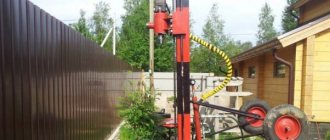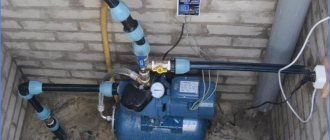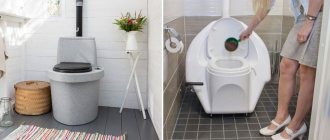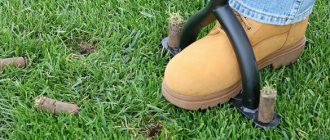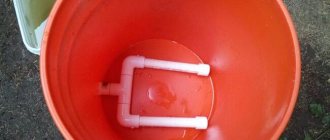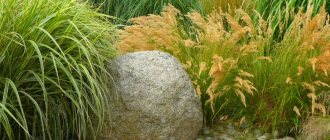Providing a site with water is the first task of its owner. The more ambitious the plans for improving your territory, the more acutely the lack of water supply will be felt. Water is needed for construction work, for the garden you are planning to create, and for your own daily needs.
If you make a water well with your own hands, your dream of water supply will not only come true, but will also allow you to save significantly. We will tell you the best way to drill and what kind of equipment independent craftsmen will need. Taking into account our advice, you will easily arrange your own water source on the site.
Types of wells
A borehole is a special structure (a working or cavity in the bowels of the earth) of a cylindrical shape, with a length significantly greater than its diameter.
Devices are divided according to depth and method of penetration. The depth of the well is determined by the location of the aquifers and the required fluid quality. Based on the terrain, aquifers are located in the earth's crust in different ways.
If the landscape is flat, then there is a high probability that water lies along the entire perimeter. If there are hills, it is recommended to drill in lowlands. The classification of structures contains several varieties.
Where to drill
Before starting any work, the hydrogeological situation should be clarified. The best source of information is the owners of surrounding properties , especially if they already have wells or have once tried to build them.
The second way to properly make a water well, or rather, choose a place for it, is to search for hydrogeological maps of your area, which can be stored in design organizations or relevant departments.
If it was not possible to obtain a clear idea of the presence and nature of aquifers, you will have to take the most expensive step - order exploratory drilling . However, before this you can try one of the folk methods , for example, dowsing, which, according to some evidence, can indicate with acceptable accuracy the presence or absence of water underground.
When choosing a location for a well, you should beware of neighborhoods in the form of septic tanks, cesspools, landfills or livestock farms. If they are still nearby, then they should be at a distance of no closer than 30 m. Of course, the well should be located closer to the house. The optimal distance is 3 m.
Abyssinian well
It was first implemented by the British engineer Norton in the 19th century. The maximum depth reaches 10-15m. The design consists of a set of pipes with a diameter of up to 60 mm, which are assembled together with a threaded connection. At the end of the last link there is a “wellpoint”.
This is a sharp tip that performs several functions: it pierces the soil when installing a well and purifies water from large fractions and polluting particles. Installation of the Abyssinian consists of raising the pipe using a tripod and driving it into the ground.
The advantages include compact size, the ability to be placed in any free area, ease of maintenance and low financial costs.
The liquid rises forcibly, in the classic way - with a hand pump. Photos of the Abyssinian driving well are shown below.
Negative nuances of self-drilling
After watching videos from the Internet, many may think that drilling a well with your own hands is a fairly simple task.
In fact, drillers may encounter the following problems:
Large boulders in the trunk. When carrying out hydraulic drilling with your own hands, a large boulder or stone at almost any depth will stop the work. Due to the small diameter of the trunk, it cannot be destroyed in any way.
If the well at the dacha has a large diameter, options for breaking large boulders using auger, spoon or using a bailer are possible. To do this, a heavy load is dropped into the mine in the form of a chisel on a cable, which, under successful circumstances, can split the stone. Nobody knows how long this procedure will take; in the worst case, the well construction will have to be stopped.
Pebbles or crushed stone. The presence of large and small stones will make penetration impossible when using hydraulic methods, bailer and percussion-rope drilling. In the first case, the drill will rest against stones that prevent it from deepening, and the leaching of soil to the surface will stop due to the absence of small sand-clay fractions. The bailer will also not be able to pick up stones, and when the pipe is lowered by shock-rope, they will simply begin to spill out and the deepening will stop.
Rice. 14 Installations and components for hydraulic drilling
High groundwater level. If groundwater enters the borehole channel, you can forget about further drilling. To isolate the shaft, excavation is continued for some time to deepen the shaft, and then a steel casing is placed into it. Metal pipes are connected by welding so that they can be driven in later, and the penetration is completed inside the pipeline with a tool of a smaller diameter.
This method is suitable for situations where the well was drilled using the mechanized percussion-rope method. In this case, a casing made of welded steel pipes is driven with a heavy load (blank) weighing approximately 200 kg. When using other excavation methods, you will have to look for a welder and build a device for driving the steel casing into the ground.
Also, after installing the steel casing, a polymer pipeline made of unplasticized polyvinyl chloride (UPVC) or low-density polyethylene (HDPE) will have to be placed in the shaft several meters below the metal column. This is necessary in order to install a filter with a plug in the well, which is placed at the end of the polymer column.
Rice. 15 A well in the country and its reverse pumping with a vibration pump
Well on sand
The structure is deepened to 15-40m. The trunk is formed by a pipe with a cross section of 100-180mm. At its end there is a stainless filter element welded to the first link of the drill string. The average service life of the product with constant use is 15 years.
When the well becomes silted or contaminated, it is washed out. If the process does not lead to the desired result, then it will be necessary to drill a new shaft located near the previous one.
Among the positive aspects, one can highlight a reasonable price compared to an artesian well, and a lower content of dissolved iron.
Device and circuit
The diagram shows water layers. The high water is fed by precipitation and lies at a depth of up to 10 meters. The quality of the water allows it to be used immediately for drinking. A source with interstratal waters is made independently. To obtain better quality water, an artesian well is made.
According to SNiPs and established standards, the source is protected from any kind of pollution. The distance from the septic tank is 15 meters. Cesspools at least 50 m away. More than 100 meters from warehouses and industrial enterprises. The distance from a neighboring source, residential buildings, chicken coops and barns is also taken into account.
Advice: drilling a well for water near trees with a large root system is difficult.
Artesian well (for limestone)
Structurally, it resembles a sand well. The main difference is the absence of a filter mesh in the lower section of the pipes and the depth of the source. Water from such structures comes from aquifers located in the limestone layer. Thanks to this, it turns out clean, with a small degree of mineralization.
Advantages:
- Performance. Capable of providing consumers with liquid in volumes from 1 to 3 m3/hour.
- Continuous water supply. Water output is not affected by pump operating time. In five-minute or two-hour mode, the flow rate is the same.
- Bacteriological purity. Artesian layers are practically not subject to pollution from the upper layer of soil and sewage runoff.
- Long service life. Operation of a well with one pipe occurs for 20-30 years. When using 2 pipes (a plastic one is inserted into an iron one), it functions for up to 50 years.
There is only one significant drawback - the high price.
How to drill with your own hands at the dacha or in a private house
Perform a number of preparatory steps:
- The selected location should not be the lowest point on the site.
- The ground slope is no more than 35 degrees.
- When using special drilling rigs, it is important to organize a place for access.
- The area on the summer cottage must be at least 4 by 9 m.
Advice: manual drilling of water wells requires less preparation, but when it comes to using special equipment, it is necessary to coordinate all the nuances.
Instructions for constructing a well
- Determine the drilling location.
- Prepare the tools: drill (auger, bailer), winch, rods, pump, shovel and pipes for casing. Creating a deep well is impossible without a drilling rig. Its height is chosen slightly greater than the total length of the rod.
- Dig a pit 1.5x1.5x2m. Protect the walls of such a recess with boards or plywood. The hole is necessary to prevent shedding of the surface layers of the soil during the drilling process.
- The assembled drilling tool is installed vertically and immersed in the ground. Every 50cm. the drill is removed from the ground using a winch and cleaned. Drilling continues until the aquifer is reached.
- Once water is detected, casing pipes are installed and a caisson is made. A caisson is a chamber for housing a pump. Common materials for its construction are plastic, brick, concrete or metal.
- Pumping equipment is connected.
New Year in the yard: how to beautifully decorate the yard with your own hands!- How to make a modern landscape design with your own hands?
Microgreens at home
Getting started is not very difficult. The drill easily digs into the soil. But with each new dive, drilling becomes more difficult. If the drill gets stuck and does not rise to the surface, it is recommended to turn it counterclockwise and try to get it out.
Maintenance and operation
The entire installation should be checked once a year to ensure it is working properly. First, the pipeline is inspected. If a leak is found, it should be repaired. It is recommended to check the pressure in the system; you need to turn off the pump and open the water intake valve. It is necessary to ensure the correct operation of the pumping equipment and hydraulic tank. The automation must function properly.
Particular attention is paid to the source during the cold season. It is necessary to ensure that the water does not freeze in winter. The casing should be insulated up to the freezing level of the soil in your area.
Advice! If the source is used seasonally, then in early spring the water should be pumped.
Connecting a hydraulic accumulator, automation
To fully equip a water well, it is necessary to install a pump, equipment and automation, which include a hydraulic accumulator, relay and pressure gauge, in the prepared caisson pit. If you use a station, all the components necessary for water intake are collected in one module, all that remains is to connect its input to the pressure pipe through a compression fitting and in a similar way connect it to the water supply supply to the residential building.
When connecting a pumping station, the help of a specialist and the use of special tools are optional - the HDPE pipeline is connected with straight or angled threaded compression fittings manually, or using a wrench on metal parts.
Visual methods for searching for groundwater
All methods used by specialists to determine the depth of the aquifer are based on accumulated experience and centuries-old observations, as well as on the properties of groundwater and their impact on the environment.
The best option is when the methods described below are used comprehensively, because Despite the high reliability, none of the methods provides a 100% guarantee.
Method #1 - vegetation on the site
Studying the vegetation of natural origin will help determine the level of perched water in your area. Pay attention to those plants that remain green and lush even in the driest period.
Approximate value of groundwater depth by plant type:
- cattail and reed, sedge - 1-3 m;
- black poplar - 1-3 m;
- wormwood - 3-6 m;
- alfalfa - 10-15 m.
The shallow location of the aquifer is indicated by trees such as cedar, willow, alder, and birch. But the presence of a pine tree on the site, on the contrary, indicates that the groundwater lies quite deep. If a well is drilled for economic purposes, then an area with such vegetation is quite suitable.
Please note that annual plants are not indicators of the depth of the aquifer, because they have a short root system and receive the necessary moisture from natural precipitation, dew or perched water.
Method #2 - terrain in the area of the site
In most cases, the aquifer follows the surface topography of the area. That is why it is best to choose a low-lying area for drilling, because there the water will be closest to the surface. Also, the presence of an aquifer is indicated by longitudinal differences in the area, but it is quite difficult to notice them with an inexperienced eye.
Drilling in a lowland is preferable, since the drilling depth is reduced, and hence the financial costs of constructing a water-bearing well.
Despite the fact that lowlands are preferable for drilling, it is impossible to drill a well in wetlands, due to the fact that in the event of depressurization of the mine shaft, very low quality water will flow into the well from the surface, constantly flooding the pit.
Also, the choice of location for a water well depends on the characteristics of the soil: it is advisable to drill in a place where the soil is best suited for development. In this case, sands, loams and sandy loams are much more preferable than rocks.
Method #3 - influence of nearby bodies of water
If there is a natural body of water (lake or river) within a radius of 300-500 m from your site, then with a high degree of probability the aquifer will be located at any point on the site. In this case, the rule applies: the closer to a natural reservoir, the higher and more abundant the aquifer will be.
When considering the distance of a site from a natural body of water, do not forget to take into account such factors as the discharge of sewage or industrial waste into it. In this case, the presence of a lake or river nearby will be more likely a negative phenomenon than a positive one.
This is especially true for sandy soils, which have high filtration rates, and if mechanical pollution is on the way to your site, it will most likely be filtered out. But harmful chemical compounds will probably get into the groundwater, and from there into the well site.
Clay rocks have low filtration characteristics, so the distance between the source of pollution and the water intake can be somewhat reduced. It is possible to construct a well on a layer of sand lying between clay soils.
If there is a negative impact on a nearby natural source of water, constructing a shallow well is impractical; in this case, drilling to artesian waters is necessary
Method #4 - folk signs and observations
There are folk signs that our ancestors used when searching for underground water. Such signs include the abundance of morning dew in a certain area, as well as the accumulation of evening foggy haze. Such phenomena most likely indicate that groundwater is located close to the surface of the earth.
You can also make a prediction about the depth of water by studying the behavior of domestic animals in hot weather. Dogs do not like to lie where the aquifer comes close to the surface of the earth, but cats, on the contrary, choose such places to spend their time.
The shallow depth of water attracts insects; they swarm over such a place during and after sunset. But rodents and ants stay away from such places, preferring drier soils.
Of course, you shouldn’t completely rely on folk signs, but it wouldn’t hurt to take them into account in conjunction with other signs. Using folk clues, you can determine the location for the construction of an Abyssinian well.
Equipment
To drill a well on a site with your own hands, you need to prepare the following elements:
- Tripod: assembled from three steel pipes or logs with a diameter of 16 cm. At the top point, the structure is connected by a pin.
- The following types of drill bits: a spoon drill (for sand and clay), a chisel (can be straight and cross-shaped) for hard rocks, as well as gravel and pebble layers, and a serpentine drill bit for clay. The quicksand pass with the help of the already mentioned bailer.
Different types of drill heads - Motor pump: used to supply the washing solution to the soil development area.
- Drill rod: assembled from 3-meter sections connected by means of a coupling or thread. A specially made rod can be replaced with water or gas pipes.
- Swivel.
- Winch.
- Geared motor.
- Pump.
- Steel or polymer pipe for casing. Its diameter is selected so that there is a gap of at least 5 mm (preferably 10 mm) between the walls and the pump installed inside.
- A filter column, which is a pipe with a filter and sump attached to it. You can make the filter yourself using the same scheme as for the Abyssinian well.
- Caisson.
Scheme of a household installation for drilling a well
Read about the characteristics and advantages of HDPE casing pipe with threads for wells in our separate article.
A comparison of wells and boreholes is available on this page of the site. All the pros and cons of these water intake sources.
How to connect a hydraulic accumulator to create a complete water supply system is described here https://okanalizacii.ru/vodosnabzhenie/nasosy-i-stancii/shema-podklyucheniya-gidroakkumulyatora-dlya-sistem-vodosnabzheniya.html


